
|
Sale 114
The New York Sale
| Lot |
Photo |
Description |
Bidding |
Lot 426 |
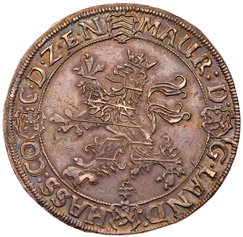 |
Hesse-Cassel. Moritz (1592-1627). Silver Taler, 1624-TS. Legend with four arms, crowned Hessian lion in center, mintmaster TS below. Rev. Crossed banners separating date, palms above, sundial below (Dav 6723; KM 69.2; Hoffman 727). In PCGS holder graded AU Detail (Repaired), original toning with a hint of underlying luster. Value $500 - UP
View details and enlarged photos
|
|
Lot 427 |
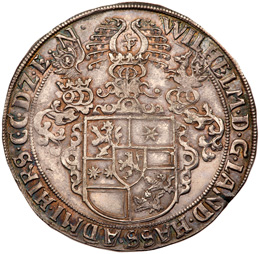 |
Hesse-Cassel. Wilhelm V (1627-1637). Silver "Storm" Taler, 16Z8-TS. Three helmets above shield of arms including mintmaster TS (Terenz Schmidt, 1621-1634). Rev. Lightning and wind blowing against tree, sun above with Hebrew "JEHOVAH", date in legend (Dav 6736; KM 98.2; Schutz 744). In PCGS holder graded AU 55, attractive toning with a hint of underlying luster. Value $750 - UP
View details and enlarged photos
|
|
Lot 428 |
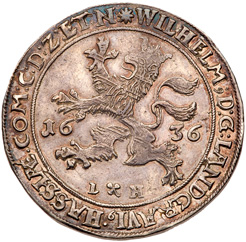 |
Hesse-Cassel. Wilhelm V (1627-1637). Silver "Storm" Taler, 1636-LH. Crowned lion left dividing date with Mintmaster L H (Lubert Haussmann, 1635-1638) below. Rev. Tree in storm, sun above with Hebrew "JEHOVAH" (Dav 6755; Hoffman 6121; KM 143). In PCGS holder graded AU 58, light toning with underlying luster. Value $750 - UP
View details and enlarged photos
|
|
Lot 429 |
 |
Kempten. City. Taler, 1546. Crowned half figure bust of Charles V, holding sword and orb facing right. Rev. Crowned shield with three smaller shields around (Dav 9365). In PCGS holder graded XF 45, with original old tone. Value $300 - UP
View details and enlarged photos
|
|
Lot 430 |
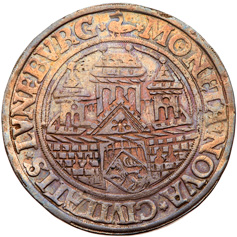 |
Lüneburg. City. Silver"Man in the Moon" Taler, 1547. City gate with three towers, city arms on gate. Rev. Man in the moon facing right, in circle, date in legend (Dav 9419; KM MB65; Schnee 7). In PCGS holder graded XF Detail (Edge Repaired). Value $800 - UP
Ex Garrett Sale, lot 1365.
View details and enlarged photos
|
|
Lot 431 |
 |
Mansfeld-Artern. Volrat VI, Jobst II, Wolfgang III (1627-1738). Silver Taler, 1616-AK. Helmeted arms dividing A-K. Rev. St. George and dragon with orb above in field (Dav 6950; KM 13). In PCGS holder graded AU 58, with beautiful iridescent toning and original mint fresh luster. Value $400 - UP
View details and enlarged photos
|
|
Lot 432 |
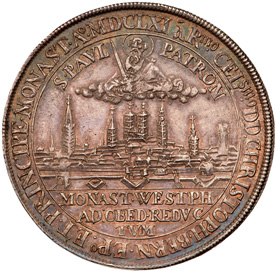 |
Münster. Christoph Bernhard von Galen (1650-1678). Silver Taler, 1661. St. Paul in cloud over city view. Rev. Helmeted arms (Dav 5603; Schulze 106e). In PCGS holder graded AU Detail (Cleaned), lustrous with attractive toning. Value $400 - UP
View details and enlarged photos
|
|
Lot 433 |
 |
Nuremberg. City. Silver Taler, 1680. Three framed shields. Rev. "Jehovah" above city view, Roman date below (Dav 5661; KM 202; Kellner 259). In PCGS holder graded XF 40. Value $400 - UP
View details and enlarged photos
|
|
Lot 434 |
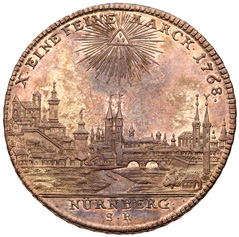 |
Nuremberg. Silver Taler, 1768-SR. City view of Nuremberg. Rev. Imperial double headed eagle with orb on breast (Dav 2494; KM 350; Kellner 284c). In PCGS holder graded AU 58, toned. Value $300 - UP
Ex Swiis Bank Auction 26, Lot 468.
View details and enlarged photos
|
|
Lot 435 |
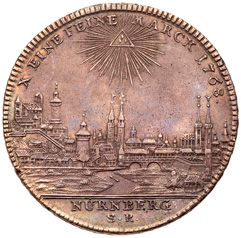 |
Nuremberg. Silver Taler, 1768-SR. City view. Rev. Crowned double eagle with orb on breast (Dav 2494; KM 350). In PCGS holder graded AU 53, toned. Value $300 - UP
View details and enlarged photos
|
|
Lot 436 |
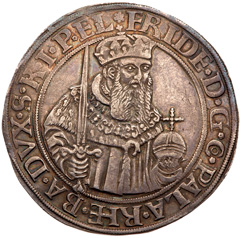 |
Pfalz. Friedrich II (1505-1556). Silver Taler, 1548. Neumarkt mint. Facing half figure holding sword and orb. Rev. Helmet over three arms, date divided below (Dav 9627). In PCGS holder graded AU 55, well struck with lovely old toning and underlying luster. Value $1,000 - UP
In 1544, after serving as a commander under the Holy Roman Emperor Ferdinand I, Friedrich II succeeded his brother as Count Palatine and Elector of the Palatinate. His reign was deeply troubled by the religious upheavals of the Reformation. In 1546, after accepting the Protestant doctrines advanced by Martin Luther, Friedrich II attempted to reform the University of Heidelberg (an old Catholic institution) along Lutheran lines. He was strongly opposed by the university and found himself outlawed by Emperor Charles V. Friedrich II only managed to save his titles and possessions by renouncing his Lutheran convictions and offering full submission to the Emperor.
The obverse of the present thaler, struck just after he was restored to the good graces of the Emperor, depicts Friedrich II in his wearing a bonnet and carrying a sword, representing his status as Count Palatine and Elector of the Palatinate. He also carries an orb, symbolizing his position as Arch-Seneschal of the Holy Roman Empire. Friedrich II possessed this high Imperial office by virtue of his reign as Elector of the Palatinate. In addition, he wears around his neck the insignia of the Order of the Golden Fleece, an Imperial chivalric honor awarded to him in 1516. The reverse features the triple-arms of Friederich II: on the left the arms of the Palatinate, on the right the arms of Bavaria, and below the arms of the Arch-Senechal of the Holy Roman Empire.
View details and enlarged photos
|
|
Lot 437 |
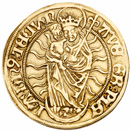 |
Pfalz-Neuburg. Otto Heinrich and Philipp (1505-1556). Goldgulden, 1515. AVE: GR: PLE - NA. DN9: TECVM. Madonna in flames holding child. Rev. +MONE: NOVA: AVREA: NEVBVRGENS. Four-part arms in quadrilobe (Fr 1988). Very Fine, Very Rare. Value $10,000 - UP
View details and enlarged photos
|
|
Lot 438 |
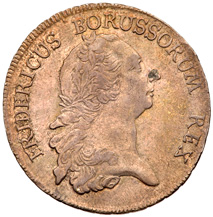 |
Prussia. Friedrich II, The Great (1740-1786). Silver Taler, 1770-B. Breslau mint. Head right. Rev. Crowned eagle above flags, drums and cannon (Dav 2586; KM 306.3). In PCGS holder graded AU 53, toned. Value $300 - UP
View details and enlarged photos
|
|
Lot 439 |
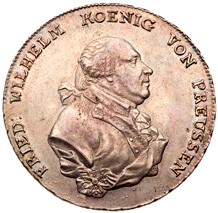 |
Prussia. Friedrich Wilhelm II (1786-1797). Silver Taler, 1791-A. Berlin mint. Uniformed bust right. Rev. Crowned and supported arms (Dav 2599; KM 360.1). In PCGS holder graded AU 58. Value $250 - UP
Ex Frankfurter Munzhandlung GmbH, Auction 140, lot 364.
View details and enlarged photos
|
|
Lot 440 |
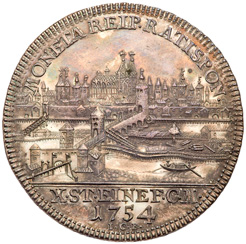 |
Regensburg. City. Silver Taler, 1754-ICB. City view with date below. Rev. Laureate bust of Francis I right (Dav 2618B; KM 371). In PCGS holder graded AU Detail (Cleaned), with reflective fields and patchy toning. Value $350 - UP
View details and enlarged photos
|
|
Lot 441 |
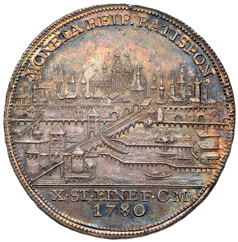 |
Regensburg. City. Silver Taler, 1780-BF. City view, date below. Rev. Laureate bust of Francis II right (Dav 2627; KM 436). In PCGS holder graded AU 55, deeply toned. Value $350 - UP
View details and enlarged photos
|
|
Lot 442 |
 |
Reuss-Schleiz. Heinrich I (1640-1692). Silver 2/3 Taler, 1678 SD. Schleiz (18.63g). Draped and cuirassed bust right. Rev. Oval arms with crowned face above (Schmidt und Knab 498, Dav 794, KM 20). Very light obverse haymarking. About extremely fine. Value $500 - UP
View details and enlarged photos
|
|
Lot 443 |
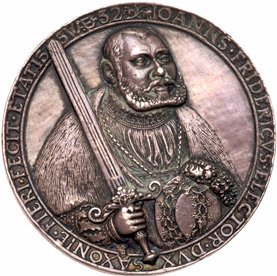 |
Saxony. Johann Friedrich (1503-1554). Silver Cast Medal, 1535. By Hans Reinhart the Elder. 62 mm. 63.1g. Three-quarter length figure of the Elector facing right, wearing a fur cape and a high collar inscribed with the abbreviated German motto: "There is no Defense against an Honorable Man", holding sword over his shoulder and electoral bonnet; IOANNS.FRIDERICVS.ELECTOR.DVX SAXONIE.FIERI.FECIT.ETATIS SVAE.32. Rev. Tri-helmeted, elaborate Ducal Arms; Latin legend: "My Hope is in God in the Year of Our Savior 1535" (Habich 1935, Domanig 154, Kress 605, Scher 126). Choice Extremely Fine. Value $1,000 - UP
View details and enlarged photos
|
|
Lot 444 |
 |
Saxony. Moritz (1541-1553). Silver Taler, 1553. Half figure bust right dividing date, with sword in right hand. Rev. Helmeted arms (Dav 9787; Schnee 689). In PCGS holder graded AU 50. Value $300 - UP
View details and enlarged photos
|
|
Lot 445 |
 |
Saxony. August (1553-1586). Silver Taler, 1570-HB. Half figure right dividing date with sword in right hand. Rev. Helmeted arms (Dav 9798). In PCGS holder graded AU 50, toned. Value $250 - UP
View details and enlarged photos
|
|
Lot 446 |
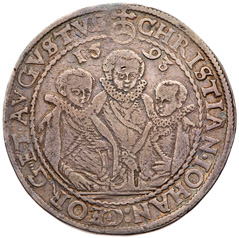 |
Saxony. Christian II, Johann Georg, August (1591-1611). Silver Taler, 1593-HB. Three brothers facing. Rev. Helmeted arms (Dav 9820; Schnee 754). In PCGS holder graded, XF 40. Value $200 - UP
View details and enlarged photos
|
|
Lot 447 |
 |
Saxony. Johann Georg I and August of naumburg (1611-1615). Silver Taler, 1613. Half figure bust dividing date right, holding sword in right hand and orb in left. Rev. Circle of eighteen shields with bust right in center (Dav 7573; KM 44). In PCGS holder graded XF Detail (Edge Repaired). Value $150 - UP
View details and enlarged photos
|
|
Lot 448 |
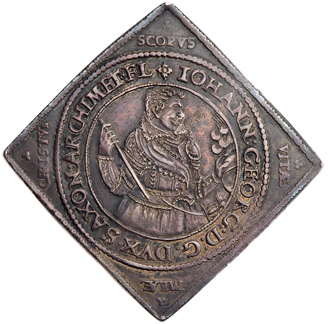 |
Saxony. Johann Georg I and August of Naumburg (1611-1615). Silver Klippe Taler, 1614. On the baptism of his son August. Half figure right with baton and helmet. Rev. Crowned crossed swords in branches, cherubs' heads in corners and date in chronogram within legend (Dav 7583; KM 72; Schnee 801). In NGC holder graded AU 55. Value $900 - UP
View details and enlarged photos
|
|
Lot 449 |
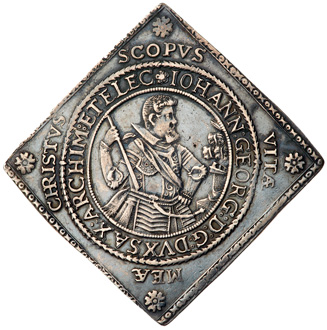 |
Saxony. Johann George I and August of Naumburg (1611-1615). Silver Klippe Taler, 1615. On the baptism of his son Christian. Bust in armor right, holding sword and helmet. Rev. Crowned crossed swords in branches. Cherubs heads in corners (Dav 7587 incorrect on holder; KM 82; Schnee 805). In NGC holder graded XF Details (Environmental Damage). Value $500 - UP
View details and enlarged photos
|
|
Lot 450 |
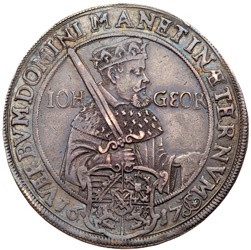 |
Saxony. Johann Georg I (1616-1656). Silver Taler,1617. On the 100th anniversary of the Reformation. Capped bust of Johann Georg right with sword divididng IOH -GEORG, arms and 1617 date below. Rev. Capped bust of Friedrch III dividing FRID; - III, with arms and 1517 date below (Dav 7595; KM 103; Merseb 1060). In PCGS holder graded AU 55, attractively toned. Value $600 - UP
View details and enlarged photos
|
|
Lot 451 |
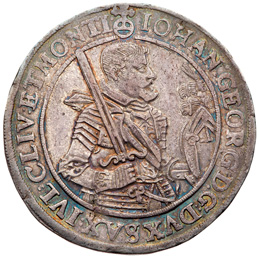 |
Saxony. Johann Georg I (1616-1656). Silver Taler, 1626-HI. Half-length armored figure right with sword in right hand and helmet in left. Rev. Helmeted arms (Dav 7601; KM 132; Schnee 818). In PCGS holder graded AU 55, with attractive old time toning and luster. Value $250 - UP
View details and enlarged photos
|
|
Lot 452 |
 |
Saxony. Johann Georg I (1616-1656). Silver Taler, 1630. On the centenary of the Augsburg Confession. Capped bust right with sword dividing 16 - 30. Rev. Capped bust right dividing 15 - 30 (Dav 7605A; KM 412). In PCGS holder graded MS 61, lightly toned with brilliant mint luster. Value $750 - UP
View details and enlarged photos
|
|
Lot 453 |
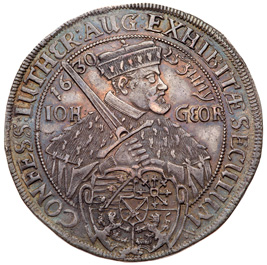 |
Saxony. Johann Georg I (1616-1656). Silver Taler, 1630. On the centenary of the Augsburg Confession. Capped bust right with sword dividing 16 - 30. Rev. Capped bust right dividing 15 - 30 (Dav 7605; KM 412). In PCGS holder graded AU 55, attractive old time tone with lovely underlying luster. Value $500 - UP
View details and enlarged photos
|
|
Lot 454 |
 |
Saxony. Johann Georg I (1616-1656). Silver Klippe Taler, 1630. On the marriage of his daughter Maria Elisabeth with Friedrich III of Holstein-Gottorp. Bust right holding sword and helmet. Rev. Clasped and chained hands in wreath, date in Roman numerals in corners (Dav 7609; KM 414; Schnee 866). Chased surfaces. Very Fine. Value $400 - UP
View details and enlarged photos
|
|
Lot 455 |
 |
Saxony. Johann Georg I (1616-1656). Silver "Death" Taler, 1656. Facing bust with sword in right hand, legend in two outer circles. Rev. Ten line inscription (Dav 7614; KM 451). In PCGS holder graded AU Detail (Cleaned). Value $400 - UP
View details and enlarged photos
|
|
Lot 456 |
 |
Saxony. Johann Georg II (1656-1680). Silver Vicariat Taler, 1657. On the death of the Emperor Ferdinand III. Duke on horseback with arms below. Rev. Twelve line inscription with full name and titles of elector (Dav 7630; KM 481). In PCGS holder graded AU 55, attractive original tone with underlying luster. Value $500 - UP
View details and enlarged photos
|
|
Lot 457 |
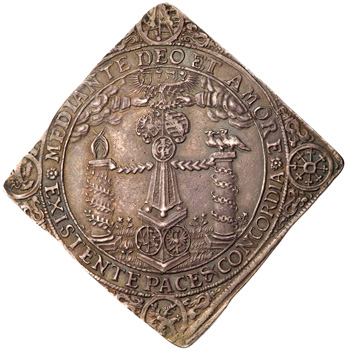 |
Saxony. Johann Georg II (1656-1680). Silver Klippe Taler, 1662. On the occasion of the marriage of his daughter, Ermuthe Sophie to Christian Ernst of Brandenburg-Bayreuth. Arms with wreath from clouds over pillars and monument. Legend around, arms in four corners. Rev. Arms in four corners, nine-line inscription within circle (Dav 7631; KM 500; Schnee 914). In PCGS holder graded AU 55, evenly toned. Value $1,000 - UP
Klippe coins were originally struck under adverse conditions, particularly during sieges, when it was difficult to obtain traditional circular flans, but square or diamond-shaped pieces could be easily cut from metal sheets - sometimes even silver plate. However, by the seventeenth century, the klippe form had become popular for distinguishing commemorative issues from regular circulating coins. The present thaler of Johann Georg II, the Elector of Saxony, is just such a commemorative issue. It was struck to commemorate the marriage of his daughter Erdmuthe Sophie to her cousin Christian Ernst, the Margrave of Brandenburg-Bayreuth, on October 29, 1662. The reverse type serves to represents the surrounding motto, MEDIANTE DEO ET AMORE EXISTENT PACE ET CONCORDIA ("Let there be peace and concord through the mediation of God and love"). Two pillars representing peace (topped by two doves) on the right and concord on the left are bound by a chain composed of hearts (representing love) to a central obelisk crowned from the heavens below the Hebrew name of God. Whereas similar celestial crowning scenes normally involve a single manus Dei (hand of God), here the crown is lowered by two hands at the ends of arms wearing the turned-back sleeves of contemporary fashion. This it is somewhat unclear who (singular or plural?) is really crowning the monument. The importance of peace, love, and concord in a marriage notwithstanding, the type also advertises the political nature of the marriage through the prominent display of the arms of the Electorate of Saxony and the Margraviate of Brandenburg at the base and top of the obelisk.
View details and enlarged photos
|
|
Lot 458 |
 |
Saxony. Johann Georg II (1656-1680). Silver Klippe Taler, 1669. On the birth of his grandson Johann Georg IV. Monogram of IG 4 in center, arms in four corners. Rev. Young Hercules in a cradle strangling a snake. In corners date, M. -D. - C. - LXIX (Dav 7632; KM 528). In NGC holder graded MS 63, with original mint fresh luster and toning. Value $1,500 - UP
This klippe thaler continues the Hercules theme that Johann Georg II perpetuated throughout his reign as Elector of Saxony but now turns it into a dynastic motif on the occasion of the birth of his grandson Georg IV. Here the childhood of Hercules is invoked to cast the new addition to the House of Wettin in the same light as his grandfather. According to myth, when Hercules was a small child, Hera, the wife of philandering Zeus sent serpents to kill him as he slept. However, upon their entry to his room, Hercules awoke and used his superhuman strength to strangle them in his hands. The depiction of this mythological scene shows a familiarity not only with the description of the event from Pindar, but perhaps also with Renaissance representations, particularly a medal struck by Ercole d'Este, Duke of Ferrara (1471-1505) on the occasion of the birth of his son in 1476. Just like Johann Georg II, Ercole (not surprisingly given his name) frequently used Hercules to represent his heroic character and martial prowess. The custom of representing royal and noble heirs as the young Hercules slaying the serpents soon became fashionable throughout Europe. For example, James Stuart, the hapless son of James II of England is depicted this way on medals of 1688 and the future Josef II of Austria on medals of 1741.
View details and enlarged photos
|
|
Lot 459 |
 |
Saxony. Johann Georg II (1656-1680). Silver Klippe Taler, 1678. For the shooting match at Dresden. Capped arms in Order band with motto, arms in four corners. Rev. Hercules standing with club, 1 THAL below, date in Roman numerals (Dav 7636; KM 562; Schnee 960). In NGC holder graded MS 62. Value $1,500 - UP
The obverse of this klippe thaler features uses heraldry to advertise the honors and possessions of Johann Georg II. In the center, the arms of the Arch-Marshal of the Holy Roman Empire are surrounded by the English Order of the Garter while the arms of the United Duchies of Jülich-Cleves-Berg are depicted in the left, right, and bottom corners. The arms of the Duchy and Electorate of Saxony appear in the top corner. The German reverse inscription EINWEYH D NEUEN SCHIESHAUSES informs us that the coin was struck to inaugurate a new shooting gallery for the Schützenfest held in Dresden in 1678. Hercules is depicted here as the patron of archery. Although he carries no bow, the Greco-Roman hero is shown holding his club in his right hand and an apple of the Hesperides in his left. According to the literary tradition preserved in the Argonautica of Apollonius Rhodius, Hercules obtained the apples by shooting the guardian dragon Ladon with arrows poisoned with the blood of the Hydra. Hercules also plays into the public image that Johann Georg II actively developed for himself. The image of the hero was regularly invoked on the anniversaries of his investiture as Elector of Saxony and celebrated in firework displays related to his exploits. A Schützenfest celebrated in connection with this anniversary in 1675 involved shooting at targets in the shapes of Ladon, the Lernean Hydra, and Cerberus.
View details and enlarged photos
|
|
Lot 460 |
 |
Saxony. Johann Georg II (1656-1680). Silver Klippe Taler, 1678. For the shooting match at Dresden. Bust right with arms in four corners. Rev. Arms in four corners, center inscription within wreath (Dav 7635; KM 561; Schnee 959). In NGC holder graded AU 55, with attractive old toning. Value $1,200 - UP
View details and enlarged photos
|
|
Lot 461 |
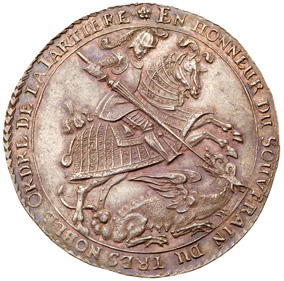 |
Saxony. Johann Georg II (1656-1680). Silver Taler, 1678. On his election to the Order of the Garter. St. George slaying the dragon. Rev. Nine line inscription within laurel wreath (Dav 7633; KM 565; Schnee 942). In PCGS holder graded MS 62, toned with sharply struck details. Value $700 - UP
View details and enlarged photos
|
|
Lot 462 |
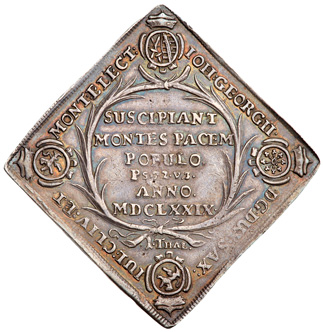 |
Saxony. Johann Georg II (1656-1680). Silver Klippe Taler, 1679. For the Peace of Nijmegen. Inscription within wreath, arms in four corners. Rev. Hand from cloud (Heaven) holding wreath over Hercules standing on cloud (Dav 7637; KM 564). In NGC holder graded XF 40. Value $750 - UP
View details and enlarged photos
|
|
Lot 463 |
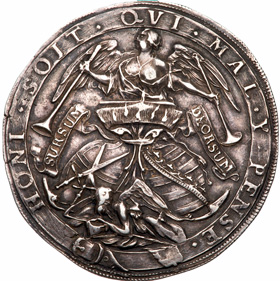 |
Saxony. Albertine. Johann Georg II (1656-1680). Silver Taler, 1680 (27.77g). On the Death of Johann Georg II. Fame, holding a trumpet in each hand, above capped shields, Saturn below. Rev. 16-line legend (Dav 7638, KM 572). Some tooling in margins. Nice old tone. Extremely fine. Value $750 - UP
View details and enlarged photos
|
|
Lot 464 |
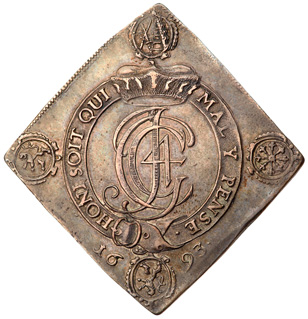 |
Saxony. Johann Georg IV (1691-1694). Silver Klippe Taler, 1693. On his receiving the Order of the Garter. Monogram JG 4 in garter band with inscription around, arms in four corners. Rev. Capped wreath with crossed swords, 1 THAL below, arms in four corners (Dav 7649; KM 642; Schnee 977). In NGC holder graded XF 45. Value $500 - UP
View details and enlarged photos
|
|
Lot 465 |
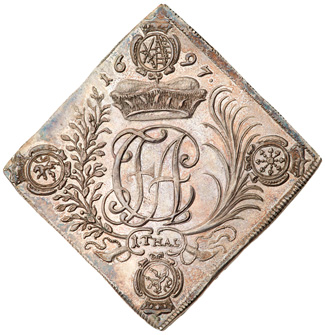 |
Saxony. Friedrich August I (1694-1733). Silver Klippe Taler, 1697. Crowned monogram FAC in sprays with 1 THAL below, arms in four corners. Rev. Hand from cloud (Heaven) holding wreath over Hercules standing on cloud (Dav 7654; KM 686; Schnee 989). In NGC holder graded AU 58, attractively toned with underlying luster. Value $1,200 - UP
The Hercules reverse type of this klippe thaler was originally used for thalers struck by Johann Georg II to commemorate the Peace of Nijmigen that formally ended the Holy Roman Empire's involvement in the Franco-Dutch War in 1679). However, in 1697, when the present piece was produced for Friedrich August I it may have been intended to allude to the recently concluded Treaty of Ryswik, which brought an end to the War of the League of Augsburg (1688-1697) fought between Louis XIV of France and a coalition composed of the Holy Roman Empire, Spain, Portugal, England, Scotland, the Dutch Republic, Sweden, and Savoy. Under the terms of the treaty, Friedrich August I, the candidate preferred by Emperor Leopold I, was named King of the Commonwealth of Poland-Lithuania (an elected title). The reverse type depicting the Greco-Roman hero Hercules crowned by the manus Dei (hand of God) is an allegory for the elevation of the Elector of Saxony to his new royal dignity. Friedrich August I was renowned for his great fortitude and was variously known to contemporaries as "August the Strong," "the Iron Hand," and "the Saxon Hercules." The Elector of Saxony frequently enjoyed amazing the members of his court with feats of strength. One particularly (in)famous example is the occasion when he personally joined his nobles in an animal-tossing contest. Some 647 foxes, 533 hares, 34 badgers, and 21 wildcats were killed during the festivities in which they were flung from large slings. Friedrich August I impressed the crowd when he held the end of his sling with only one finger while the other had to be held by two of the strongest courtiers. Also, like Hercules, the Elector of Saxony fathered a prodigious number of illegitimate children. Hence, the image of a crowned Hercules would have immediately invited comparison with the newly crowned King of Poland-Lithuania in Saxony.
View details and enlarged photos
|
|
Lot 466 |
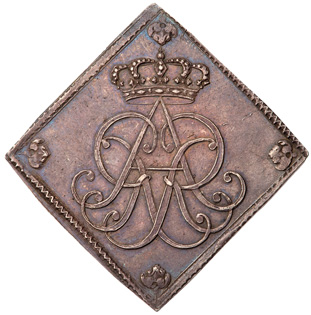 |
Saxony. Friedrich August I (1694-1733). Silver Klippe Shooting Taler, 1708. Crowned AR monogram. Rev. Shooting range in center with band around (Dav 2651; KM 770; Schnee 1006). In NGC holder graded MS 61. Value $1,000 - UP
Friedrich August I had a reputation as a builder and a patron of culture within the Electorate of Saxony. Impressed by the splendor of Louis XIV's Palace of Versailles, the Elector emulated the opulence of the French Sun King in his development of Dresden Castle and his summer residences at the castles of Moritzburg and Huburtusburg. In 1723, he established the Grünes Gewölbe ("Green Vault") as the first public museum in Europe with a remarkable collection of paintings. Also following the absolutist style of Louis XIV, Friedrich August I frequently sponsored lavish entertainments for the nobility-after all if the nobles were at court for masquerade balls or frivolous games and contests they could not be elsewhere plotting to undermine the central authority. In addition, the Elector of Saxony himself seems to have taken great pleasure in such entertainments.
The present klippe thaler commemorates the inauguration of a shooting gallery ZU ERGETZNUNG DER VERSAMLETEN STAENDE ("for the entertainment of the assembled Estates") on February 13, 1708. This was constructed for a Schützenfest (shooting festival)-an annual marksmanship competition that evolved from medieval training drills for Dresden's town militia. The detailed bird's-eye view of the range reveals that seven people could compete at once, apparently shooting from within ornamental arches or pavilions offering protection from sun and rain. The large central arch/pavilion was reserved for the Schützenkönig ("King Marksman"), the victor in the previous year's Schützenfest. Participants could shoot at circular targets at the far end or at a wooden eagle raised on a pole in the middle of the range. When the eagle served as the target, specific numbers of points were awarded for shooting off different features of the bird based on difficulty.
View details and enlarged photos
|
|
Lot 467 |
 |
Saxony. Friedrich August I (1694-1733). Silver Vicariat Taler, 1711. King on horseback right, with shield below. Rev. Two sets of crowns and scepters on tables. Below in wreath inscription (Dav 2655; KM 803; Schnee 1011). In PCGS holder graded MS 62, attractively toned. Value $1,000 - UP
The present coin is known as a vicariat thaler because it was struck between the death of Josef I on April 17, 1711 and the election of Carl VI as his imperial successor on October 12, 1711. During this period, Freidrich August I, served as Imperial Vicar. Ever since the basic constitution of the Holy Roman Empire was codified by the Golden Bull of 1356, the Duke and Elector of Saxony and the Count Palatine of the Rhine were appointed Imperial Vicars who would take up the administration of the Empire in the interregnum that inevitably followed the deaths of Emperors when their successors had not already been chosen. As Duke and Elector of Saxony and Imperial Vicar, Friedrich August I ruled with the powers of the Emperor in the northern territories of the Holy Roman Empire for 5 months and 25 days while his counterpart, Johann Wilhelm II, Count Palatine of the Rhine ruled in the south.
On the obverse Friedrich August I is depicted wearing a crown and charging on horseback while on the reverse he is named in Latin as King Elector. These royal features refer to the fact that at the same time that he served as Duke and Elector of Saxony and as Imperial Vicar within the Holy Roman Empire, he also ruled in his own right as King of the Commonwealth of Poland-Lithuania (1697-1706 and 1709-1733) (as Augustus II). The arms of the commonwealth appear below his horse. Likewise, the treatment of his horse's mane and the animal skin that adorns it seems to be intended to recall the appearance of the mounts of the famous Polish hussars-the elite cavalry of Poland-Lithuania that played a decisive role in defending the commonwealth against the Ottoman Turks as well as the Kingdom of Sweden and the Tsardom of Russia in the sixteenth and seventeenth centuries.
The reverse type advertises the two offices of King and Elector held by Friedrich August I. The throne and robe on the left is topped by a royal crown and scepter while those on the right are topped by the ducal bonnet and sword of the Electors of Saxony. They seem to be shown set aside as if to indicate that Friederich August I has set aside his personal concerns in his own kingdom and electorate in order to take up the role of Imperial Vicar and shoulder the problems of the Empire as a whole until the election of the new Holy Roman Emperor.
View details and enlarged photos
|
|
Lot 468 |
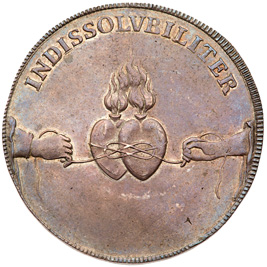 |
Saxony. Friedrich August I (1694-1733). Silver "Marriage" Taler, 1719-IGS. On the marriage of the Electoral Prince with the Archduchess M. Josepha of Austria. Two hands binding flaming hearts. Rev. Nine line inscription (Dav 2660; KM 840; Mersb 1527). In PCGS holder graded MS 62, lustrous with light steel gray toning. Value $1,500 - UP
View details and enlarged photos
|
|
Lot 469 |
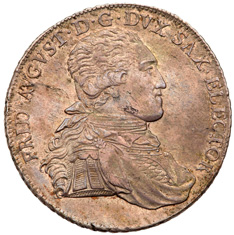 |
Saxony. Friedrich August III (1763-1827). Silver Taler, 1795-IEC. Armored bust right. Rev. Crowned oval arms within branches (Dav 2701; KM 1027.2). In PCGS holder graded AU 55, toned with underlying luster. Value $150 - UP
View details and enlarged photos
|
|
Lot 470 |
 |
Saxe-Altenburg. Four Sons of Friedrich Wilhelm I of Weimar (1602-1625). Silver Taler, 1623-WA. Half-figure right dividing date. Rev. Three half figures right with two shields below (Dav 7371; KM 302; Schnee 278). In PCGS holder graded XF 45, attractively toned. Value $250 - UP
View details and enlarged photos
|
|
Lot 471 |
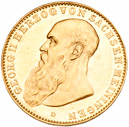 |
Saxe-Meiningen. George II (1866-1914). Gold 20 Marks, 1910-D. Head left with long beard. Rev. Crowned imperial eagle with shield on breast. Mintage of only 1,004 (Fr 3860; KM 205; J 281). Brilliant Uncirculated, Very Rare. Value $18,000 - UP
View details and enlarged photos
|
|
Lot 472 |
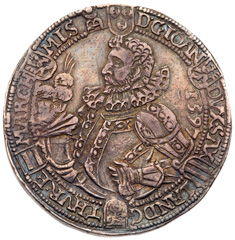 |
Saxe-Old-Weimar. Friedrich Wilhelm I and Johann III (1573-1602). Silver Taler, 1597. Bust in high collar left with helmet before. Rev. Bust right with helmet in front (Dav 9777; Schnee 250). In PCGS holder graded AU 50, well struck with original old toning. Value $300 - UP
View details and enlarged photos
|
|
Lot 473 |
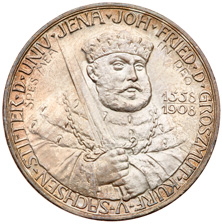 |
Saxe-Weimar-Eisenach. Wilhelm Ernst (1901-1918). Silver 5 Mark, 1908-A. For the 350th anniversary of the founding of the University of Jena. Facing bust with sword. Rev. Eagle (Dav 849; KM-Y175; J-161). In PCGS holder graded MS 65. Value $200 - UP
View details and enlarged photos
|
|
Lot 474 |
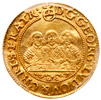 |
Silesia-Liegnitz-Brieg. Georg, Ludwig and Christian (1639-1663). Gold ½ Ducat, 1656 (1.71g). Three half-length busts facing. Rev. Ornate crest with three helmets (Fr 3201; KM 378). In PCGS holder graded MS 61, sharply struck with original mint brilliance. Value $1,500 - UP
Ex Superior Galleries, Moreira Sale, May 31- June 1, 1988, lot 215.
View details and enlarged photos
|
|
Lot 475 |
 |
Stolberg. Wolfgang Georg (1615-1631). Silver Taler, 1626-CZ. Helmeted arms with divided date in helmets, C-Z in field. Rev. Orb above stag left (Dav 7778; KM 52). In PCGS holder graded AU 53, toned. Value $400 - UP
View details and enlarged photos
|
|
|
|